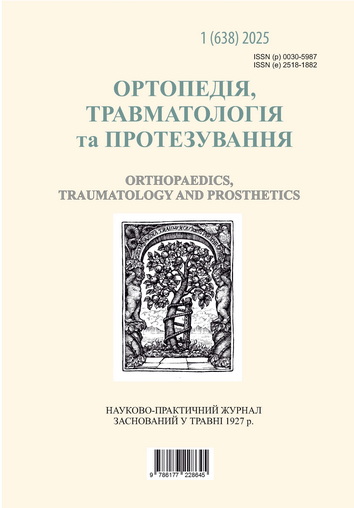ANALYSIS OF POSTOPERATIVE COMPLICATIONS IN THE SURGICAL TREATMENT OF PROXIMAL HUMERAL FRACTURES IN PATIENTS WITH DECREASED MINERAL BONE DENSITY
DOI:
https://doi.org/10.15674/0030-59872025137-44Keywords:
Proximal humerus fracture, reverse total shoulder arthroplasty, RTSA, complications, Constant-Murley Score, reduced bone mineral density, functional assessmentAbstract
Objective. To conduct a comparative retrospective analysis of the impact of postoperative complications on functional outcomes following different surgical treatment methods for proximal humeral fractures of AO/OTA types 11-B and 11-C in patients over 45 years old with decreased bone mineral density. Methods. The study analyzed the surgical treatment outcomes and postoperative complications in 102 patients aged (61.1 ± 8.1) years, who were divided into three groups based on the treatment method: (1) open reduction and internal fixation (ORIF) using a PHILOS plate (n = 50); (2) ORIF with a PHILOS plate combined with 3D-printed PLA implants (n = 44); (3) primary reverse total shoulder arthroplasty (RTSA) using a newly developed total reverse endoprosthesis (n = 8). Functional outcomes in patients with complications were assessed using the Constant-Murley Score at 3, 6, and 12 months postoperatively and analyzed based on individual preoperative parameters and treatment methods. Results. A total of 30 postoperative complications were recorded, the most common being superficial infection (7.8 % of the total population), secondary displacement (6.9 %), varus malalignment of fragments (6.9 %), and avascular necrosis of the humeral head (3.9 %). The highest number of complications was observed in Group (1), with 19 patients affected, accounting for 38 % . For all complications except avascular necrosis, a significant improvement in functional outcomes was observed between 3 and 12 months postoperatively. The mean Constant-Murley Score in patients with complications at 12 months postoperatively was (78.7 ± 8.5). Conclusions A retrospective analysis of postoperative complications following different surgical treatment methods established that, compared to other options, reverse total shoulder arthroplasty (RTSA) is a modern and optimal surgical treatment option for proximal humeral fractures of AO/OTA types 11-B or 11-C in the context of severe bone mineral density reduction, particularly in elderly patients.
Downloads
How to Cite
Issue
Section
License
Copyright (c) 2025 Vasyl Makarov, Mykola Korzh

This work is licensed under a Creative Commons Attribution 4.0 International License.
The authors retain the right of authorship of their manuscript and pass the journal the right of the first publication of this article, which automatically become available from the date of publication under the terms of Creative Commons Attribution License, which allows others to freely distribute the published manuscript with mandatory linking to authors of the original research and the first publication of this one in this journal.
Authors have the right to enter into a separate supplemental agreement on the additional non-exclusive distribution of manuscript in the form in which it was published by the journal (i.e. to put work in electronic storage of an institution or publish as a part of the book) while maintaining the reference to the first publication of the manuscript in this journal.
The editorial policy of the journal allows authors and encourages manuscript accommodation online (i.e. in storage of an institution or on the personal websites) as before submission of the manuscript to the editorial office, and during its editorial processing because it contributes to productive scientific discussion and positively affects the efficiency and dynamics of the published manuscript citation (see The Effect of Open Access).














